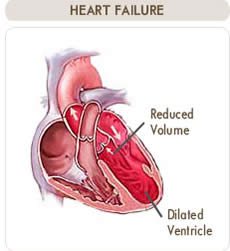Difference between Cardiac Arrest and Heart Failure
Key Difference: Cardiac Arrest is a heart condition where the heart does not contract properly, thereby failing to effectively circulate blood to the other organs. Cardiac arrest is brought on by irregular beating of the heart that causes it to stop supplying blood flow to the other organs, including the brain. Heart failure is a condition when the heart is unable to provide a sufficient pump action to maintain the blood flow, dropping the pressure by which the blood moves through the body. Heart failure is also known as congestive heart failure (CHF) or congestive cardiac failure (CCF).
Cardiac arrest and heart failure are two different conditions but can often be confusing as they are both related to the heart. The heart is an important organ that is responsible for supplying oxygen and nutrients to various other organs and tissues in the body. When the heart stops working properly it automatically disrupts the function of all the other organs. Cardiac arrest is when the heart stops working properly and is not able to pump blood to the rest of the organs. Heart failure is when the heart cannot maintain the pressure required to send blood to the rest of the organs, slowing down the pressure of the blood in the body.
 Cardiac Arrest is a heart condition where the heart does not contract properly, thereby failing to effectively circulate blood to the other organs. Cardiac arrest is brought on by irregular beating of the heart that causes it to stop supplying blood flow to the other organs, including the brain. Cardiac arrest is also known as cardiopulmonary arrest or circulatory arrest. The heart has an internal electrical system that allows it to control the rhythm of the heart; any changes to the rhythm can cause the heart to either beat too fast, too slow or stop beating completely. These changes are known as arrhythmias. The lack of blood flow leaves the other organs starved for oxygenated blood. The lack of oxygen to the brain causes the person to faint. If the person does not receive help during the first five minutes of fainting, it can result in permanent damage to the brain.
Cardiac Arrest is a heart condition where the heart does not contract properly, thereby failing to effectively circulate blood to the other organs. Cardiac arrest is brought on by irregular beating of the heart that causes it to stop supplying blood flow to the other organs, including the brain. Cardiac arrest is also known as cardiopulmonary arrest or circulatory arrest. The heart has an internal electrical system that allows it to control the rhythm of the heart; any changes to the rhythm can cause the heart to either beat too fast, too slow or stop beating completely. These changes are known as arrhythmias. The lack of blood flow leaves the other organs starved for oxygenated blood. The lack of oxygen to the brain causes the person to faint. If the person does not receive help during the first five minutes of fainting, it can result in permanent damage to the brain.
Cardiac arrest can be a cause of Coronary heart disease, cardiac abnormalities such as cardiomyopathy, cardiac rhythm disturbances, hypertensive heart disease, congestive heart failure, etc., trauma, overdose, drowning, smoking, obesity, lack of physical exercise, etc. Cardiac arrest brought on suddenly is known as Sudden Cardiac Arrest (SCA) and causes the heart to stop beating completely. Cardiac arrest differs from heart attack as in a heart attack, the heart does not receive the oxygenated blood and all the while it continues to beat and pump until the cells die completely. In cardiac arrest, the heart itself stops beating, though it still receives constant supply of oxygenated blood.
Symptoms of cardiac arrest include fainting and loss of pulse or heartbeat. The person stops breathing as the heart no longer pumps. The person that suffers a cardiac arrest must receive quick cardiopulmonary resuscitation (CPR) to keep the heart pumping the brain from losing cells. The longer it takes the person to receive help, the more chances that they may have loss of memory, brain damages or less chances of survival. Defibrillation (or shocking the heart) is another way to revive the heart. Implantable cardioverter-defibrillators (ICDs) and pacemakers are used to ensure that the person does not suffer from another cardiac arrest episode in the event of arrhythmia.
 Heart failure is a condition when the heart is unable to provide a sufficient pump action to maintain the blood flow, dropping the pressure by which the blood moves through the body. Heart failure is also known as congestive heart failure (CHF) or congestive cardiac failure (CCF). In layman’s terms, the heart has become weaker and is not able to pump with the same power as it was able to before. As it the heart pumps blood slower, the blood moves slower throughout the whole body. This causes the blood tissue to suffer ischemia, or thinning of the blood. This may cause the heart chambers to stretch to hold more blood or become stiff and thickened. The weakening of the heart pressure causes the kidneys to retain water and salt, causing fluid to build up in the arms, legs, ankles and feet.
Heart failure is a condition when the heart is unable to provide a sufficient pump action to maintain the blood flow, dropping the pressure by which the blood moves through the body. Heart failure is also known as congestive heart failure (CHF) or congestive cardiac failure (CCF). In layman’s terms, the heart has become weaker and is not able to pump with the same power as it was able to before. As it the heart pumps blood slower, the blood moves slower throughout the whole body. This causes the blood tissue to suffer ischemia, or thinning of the blood. This may cause the heart chambers to stretch to hold more blood or become stiff and thickened. The weakening of the heart pressure causes the kidneys to retain water and salt, causing fluid to build up in the arms, legs, ankles and feet.
Heart failure is actually a wrong term to describe the condition as it does not consist of the heart stopping completely. In a heart failure, the pressure by which the heart pumps blood throughout the body reduces as the heart weakens. The weakening pressure reduces the speed with which the blood flows through the body, causing many tissues and organs to not receive properly oxygenated blood. The reduction in oxygenated blood causes the kidneys to retain fluids, which causes swelling in the lower body. Heart failures are often onset by heart attacks, coronary artery diseases, high blood pressure, valve diseases, etc. Depending on the symptoms, heart failure can affect the left side ventricle or the right side ventricle. The left-side failure can cause the heart to become enlarged and overlaps with the right-side failure. The left-side failure can cause the right-side ventricle to fail as well. The right-side failure is more commonly associated with the retention of fluids and swelling underneath the skin.
There are two types of heart failure: Systolic dysfunction and Diastolic dysfunction. Systolic dysfunction is when the heart muscle does not contract with enough force, resulting in less-oxygen rich-blood to flow through the body. Diastolic dysfunction is when the heart contracts normally but the ventricles are stiff reducing the flow pressure to the rest of the body. Heart attacks can be diagnosed using blood tests, chest X-rays, echocardiogram, Ejection Fraction (EF), electrocardiogram, Cardiac catheterization and stress test.
Symptoms of heart failure include: tachypnea (increase rate of breathing), Rales, crackles, pulmonary edema (fluid in the alveoli), hypoxemia, apex beat, gallop rhythm, dyspnea, breathlessness (on lying down), wheezing, coughing, dizziness, fainting, confusion, jugular venous pressure, swelling in the feet, ankle, legs, etc., enlargement of liver, etc. Treatment includes lifestyle changes, light exercises, medications, dietary changes, pacemakers and heart transplant in the last stages.
Image Courtesy: ece.uc.edu, terumoheart.com









Add new comment